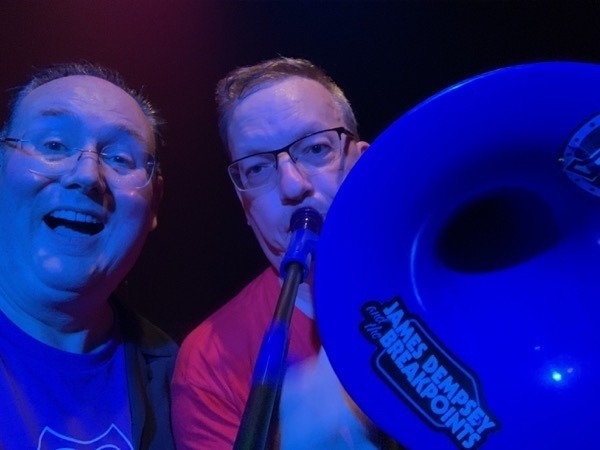Career Reminiscing
- it was in London, and I could live at home
- maybe I would get free Cable TV.
- Who are you shopping for? My dad.
- What are they interested in? Photography.
- What's your budget? $75.
- stop making its iconic black computers
- abandon work on a PowerPC-based workstation
- try selling its hardware business and factory to Canon
- focus on software
- rename the company "NeXT Software"
- lay off 300 of its 540 employees.
- there were no associates
-
Use “sndrecord ping.snd”, hit return, say the word “PING” into the mike, hit return again. Try to make the recording less than 1 second long.
-
Run this script
Half my life at Apple and NeXT
Well, I just turned 64. So half my life ago, I was 32, in September of 1991. And in September of 1991, I started work at NeXT, which then merged into Apple in 1996.
So I’ve been doing this job - with great delight! - for half my life. (I figured out the actual day when I’d spent half my life here; it was a few days ago, I won’t bore you with the calendar math.)
I had been working at Indiana University, and bought a NeXT Cube workstation for $11,000. I was fascinated with this computer. A Unix machine, with a great graphical interface, amazing built in sound, awesome object-oriented developer tools, and it’s only $11,000 with the academic discount? I’ll buy one!
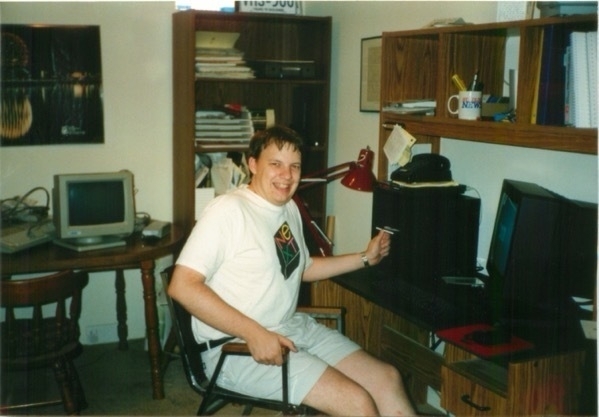
That’d be a much younger me, and my brand new NeXT cube in my Bloomington, Indiana apartment (and in the background is an Atari 520ST. It was my previous favourite thing that I think never got turned on again after I got the NeXT cube.
Of course, I still have that NeXT cube. The watch on my wrist is its direct descendant - it’s running sort of the same operating system, using sort of the same developer tools, and it’s a better computer by almost any measurement. That NeXT cube was the ancestor of everything Apple makes today.
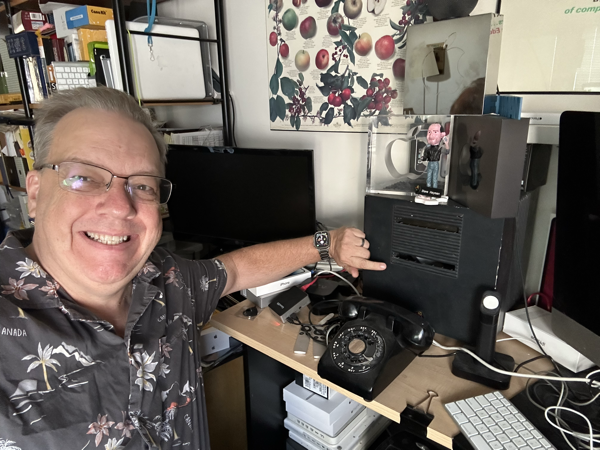
So anyway, Indiana was swell but eventually I wanted to move back to Canada, so not knowing anything about sales or anything, I asked the local rep Pat Wootan if, by any chance, did NeXT have an office in Canada and would they have any use for someone like me?
Turns out, yes! There was a sales office in Toronto consisting of a whole two people, and one of them (the “Systems Engineer”, whatever that meant) was leaving, so Pat put me in touch with Phil Hume (the “Account Executive”) and a chain of interviews started.
NeXT flew me out to Redwood City, California, and I remember a theme during the interviews. Multiple people asked me “Wait - you paid $11,000 for a Cube? Did nobody tip you off that a cheaper, faster, $2,000 NeXTStation was about to ship? Geez, I’m sorry. Maybe we can make it up to you by hiring you.” And they did, and I started in September 1991.
Here I am now, half my life put into this job. 32 years of wonder, of fascination with new technology, of nagging impostor syndrome that I still don’t really understand a lot of it, and of excitement about what comes next.
So what were YOU doing half your life ago?
May 23 2023 - 30 Years At Apple
My Apple badge says that my start date at Apple was May 20, 1993, so yesterday was officially my 30th anniversary here.
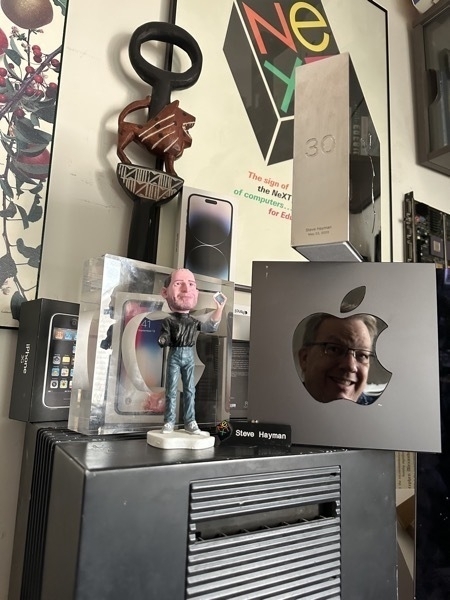
Apple sends you a beautiful block of something every 10 years, and you can see my 10th, 20th (with reflection of me) and 30th awards in the photo above. They get increasingly shiny and increasingly hard to photograph.
When they announced the 10/20/30 year awards, I think I was on year 24, and they retroactively sent the 20th one. I made a mental note to stick around long enough to see what the 30 year award looked like - and now I know. And I also know there is a 40 year award, but I’m pretty sure I won’t make it to that one. One colleague has been here 42 years and told me she’s hanging around for the mythical 50 year brick.
It’s been an amazing journey. The team I work on has pretty much turned over several times, but I keep getting to work with new, talented, funny and creative people, and I hope I can do it for a while longer. I kind of stumbled into this job but it’s unfolded brilliantly - I’ve been able to travel; I’ve given talks at over 300 universities and in over 14 countries and, I hope, inspired a few people to try writing their own iPhone apps. Apps for a device that didn’t even exist when I started here.
So what was I actually doing on May 24, 1993, my supposed start date at Apple?
I honestly don’t remember. I worked for NeXT, which Apple famously acquired, but NeXT laid me off for a year and then re-hired me later. Apple includes your time at an acquired company when computing these start dates, but somehow they decided May 20, 1993 was my actual start date even though at the time I was self employed, fumbling along as “Steve Hayman and Associates” (note: there were no associates) in between my shifts at NeXT. I started at NeXT in September of 1991. That feels more like my actual anniversary.
Speaking of the 30 year mark, I have a child rapidly approaching that milestone. Now THAT makes me feel old.
Memories of Cableshare and Videopress - 40 years of touch screens
I’ve been writing software for touch screens for a long time. iPhone and iPad today, of course - but 40 years ago, I helped build Videopress - a system from London, Ontario’s Cableshare that installed colour graphic touch screen systems in kiosks in shopping malls.
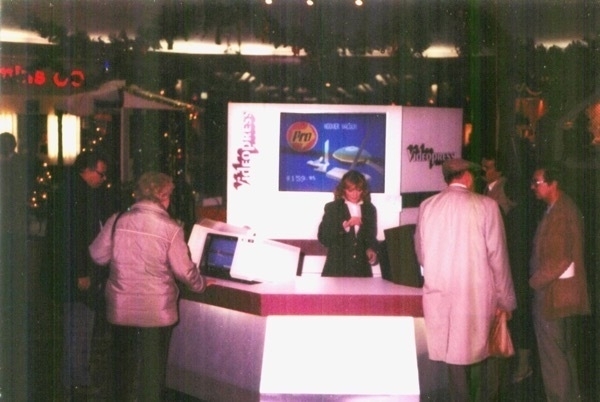
For a moment, shopping malls in London, Ontario were the center of the touch screen information universe.
It feels like all the information about this pioneering system has been lost in the sands of time. Although it only lasted a couple of years in the early 1980s, it was pretty amazing for its day. Let me write up something here for the benefit of future historians.
I gotta tell you, when I visit shopping malls today, I sometimes see touch screens and mall information systems and I think fondly of what we were doing way back then, and then I think “These systems today are not really 40 years better than what we were doing back then.”
plus I have a few stories.
Cableshare
My first job after graduating in 1981. I wanted to work for Cableshare - a small software company in London that was affiliated with the local Cable TV provider for two main reasons
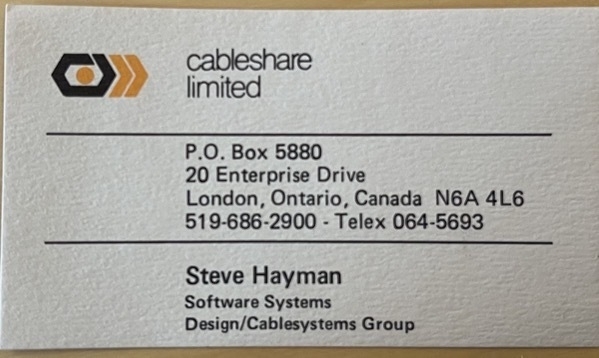 (Don't try to Telex me, I don't think it still works.)
(Don't try to Telex me, I don't think it still works.)
It worked out GREAT. I got to learn C, I got to build some cool stuff - at first, code for a cable tv monitoring system that detected fires or something in your house and called 911 - and eventually got in to graphics and touch screens, but most importantly, yes, I did get free Cable TV.
One day the boss showed me a touch screen fitted to a VT100 terminal, and one of these Telidon graphic decoder terminals, and asked me to fool around with it. Videopress was the result. I built some page creation software, the team built a booth and a distributed network to make it all work.
Cableshare's Videopress - a big deal in 1982
The picture at the top is one of our first booths. I think this is at White Oaks Mall in London, Ontario. Or possibly Westmount Mall.

Anybody could come up and use the touch screens to search for mall information, check out the news and weather, and shop through an interactive gift guide (about which, more later.) Only hobbyists had home computers back then, and certainly nobody had a cell phone, so the idea that you could just touch a screen to find something out was revolutionary.
Especially because we all grew up with our mothers saying “Don’t touch the TV screen! You’ll get an electric shock!”
I remember bringing my grandmother out to the mall to use the Videopress booth. My grandmother! Nanny! Using a touch screen! Using software I wrote! Inconceivable.
So anyway,
technical stuff
The booth featured 4 terminals from Electrohome (and later Microtel) running a graphics standard called Telidon that had been promoted heavily by the Canadian government. Telidon defined a series of commands that you could send to a decoder - send a particular sequence of bytes, and a Telidon decoder would interpret those commmands and draw, say, a blue rectangle of a certain size, or text at a certain location. Slowly. It was a very clever, resolution-independent protocol where coordinates were all expressed as numbers between 0 and 1, so everything would fit on a terminal of any resolution. (I remember getting laughed at when I asked if we could get a 1024x1024 terminal. What are we, NASA? We don’t need some super thing like that, come on.)
Cableshare had fitted Elographics touch screens on top of these monitors. Another Telidon decoder showed a loop of graphics that you can see behind the booth attendant in the photo above. It all operated over serial lines, connected via an absurdly expensive Datapac network connection to … my memory is hazy here, but I think a Vax/VMS system back at headquarters. Initially this was all run from a tremendously underpowered CP/M computer buried in the booth, with a whopping 64K of memory to keep it all running.
Picture Painter
Artists back at headquarters would create all the content using an app I wrote called the Picture Painter. Perhaps you read this glowing review of Picture Painter in PC Magazine in 1984 -
Picture Painter is not as easy to learn as it should be. It takes a lot of nerve to charge $3,000 for software and then an extra $50 for inadequate documentation.
Tough, but fair.
Here’s a historic photo of a dorky looking guy showing off the Picture Painter app he created - and in case she ever goes searching for her own name, I’d like to say hello to my Cableshare colleague Debbie Shelton, who hasn’t seen me in 40 years either.
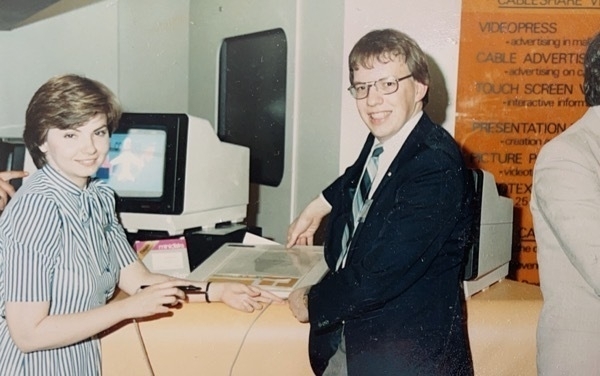
That’d be a Summagraphics tablet, with a custom overlay where you could draw and a grid of buttons across the bottom to trigger editing functions, and a Microtel Telidon terminal displaying the results.
I saved one of the overlays -
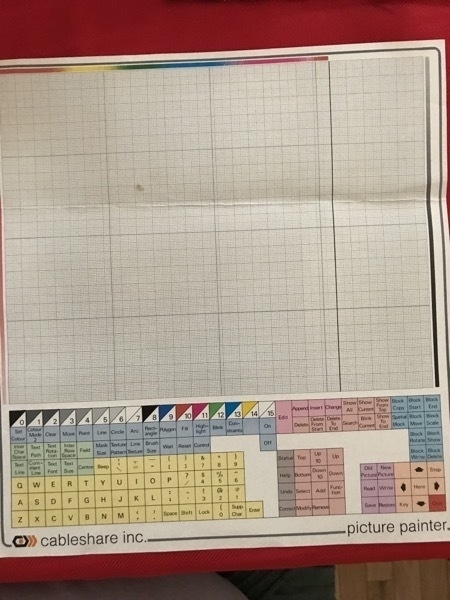
Telidon graphics were interesting in that they built up as the picture commands came in. it’d draw a circle, and a rectangle, and then it’d wait for more data to come in, and draw some text, and pause again and … It’s hard to believe how slow this was in retrospect but the effect of the pictures gradually appearing was kind of interesting.
so what did you see on the screen at the mall?
I really wish I’d taken some more pictures of what it all looked like. You’d have a menu you could touch through, for mall information, maps to the stores, the latest news and sports scores, and more. It was a clumsy menuing interface because the touch screens of 1982 were pretty limited. The first ones we used had something like twelve specific zones you could touch - and that was it. Twelve little nondynamic islands, and you had to create your content so that the touchable things were under the specific zones.
The Eaton Centre
Our first two installs were at White Oaks and Westmount Malls, in London. Cableshare had partnered with the local newspaper, the London Free Press, to build a joint venture called Videopress and they’d put Russ Demchuk in charge of the project and I’d just like to drop his name again as someone I haven’t heard from in ages.
while I’m at it a few more names of Cableshare people. This team taught me a lot. Frank Mandarino! Tom Martin! Tom McGill! Chris Reinkeleurs! Al Dinelt! Rick McNorgan! Herb Woods! Terry Pocock, rest in peace, company president who really spearheaded the whole thing. And Joe I Forget Your Last Name But You Were Very Nice To Me And I’m Sorry I Complained About One Of Your Functions Delivering Unsorted Data When I Really Wanted Sorted!
anyway. We honestly thought every shopping mall in the world would want some of these kiosks. Many of them came to London to see it in action, and the owners of the Eaton Centre - Canada’s largest mall, in downtown Toronto - decided to dive in, in partnership with the Toronto Sun.
It was all-hands-on-deck to get ready for that huge install. There was going to be a large Videopress booth smack in the middle of the mall. Our team of artists started using Picture Painter to draw - tediously - walking maps from the booth’s location to every store. 300 individual maps. I think they had animated dotted lines showing the route. Fancy stuff for 1982.
Except when the booth was installed, it turned out to be on the opposite side that we were expecting, and all the maps were upside down and had to be redrawn. Oops.
Today when I visit the Eaton Centre, I walk past the spot where the booth used to be, and I get pretty nostalgic….
Sports Scores
One piece of content I remember is a fancy graphic showing Wayne Gretzky’s quest for 100 goals. He was on a tear that season and it really looked like he might score 100; the team built an impressive page with a thermometer of sorts showing his progress, and every night it’d be updated, and there was going to be some spectacular thing happening when he hit 100.
Wayne finished the season with 92 goals. sigh.
The Gift Guide
The sales people were signing up vendors in the mall to participate in the Gift Guide. We had a coupon printer in the booth - using that ancient greasy ATM paper you’ve probably forgotten - and somebody had the idea that we should print special discount coupons that would direct people to participating retailers.
Somehow this morphed into the Christmas Gift Guide. A database driven thing, you’d answer a few questions on the touch screen …
Welcome to the Gift Guide!
and the interactive database would search through the huge list of participating merchants, and recommend something and print a coupon.
Except … The sales people had difficulty filling all the slots. Most of the time, the gift guide came up with a useless recommendation like Nothing for that combination. Try again.
shoes
One day my manager Bruce Grayson came to me and said ``Steve, this doesn’t look good you’ve got to make it return something every time.''
We thought about it for a moment, looked over the list of participating vendors, and decided we were going with Shoes. The perfect Christmas gift! Your dad is interested in photography? Why not buy him some shoes? Have you ever seen a photographer that didn’t have shoes?
I don’t think the Gift Guide lasted too long.
spinoffs
the inuit circumpolar conference
Cableshare got government money somehow to install a few systems at the Inuit Circumpolar Conference, which I believe was in Iqaluit, and I am still annoyed that I didn’t get to go. But I did manage to use Telidon’s custom font capability to design an Inuktitut font so content could be presented properly. I remember buying a sheet of Letraset dry-transfer letters that were in that font - all magical circles and triangles - and tediously creating a digital font variant. I hope people liked that.
buick
We modified the system so that it could display video from an attached laserdisc player, and somebody somehow got Buick interested in this as a kiosk for car dealerships. I remember going to see the first install at Buick HQ in Michigan. A standalone touch screen system was there to tell you about the new 1984 cars - but nobody was touching it. Nobody knew that you could actually TOUCH a SCREEN.
Someone had the bright idea to put a helpful sign next to the screen. Touch Here to learn about Our New Cars!, it said.
You can imagine where this is going. I remember seeing somebody touch the SIGN, four or five increasingly frustrated times, and of course nothing was happening. He got mad, and actually hit the real touch screen with his fist while walking away. Stupid thing. Doesn’t work.
Then, of course, the touch screen noticed an actual touch, and beeped, and started playing videos from the laserdisc player. I think the customer came back for a look.
the finger painter
Also I managed to put together a touch-screen based program that let you create graphics without the need for a keyboard or a graphics tablet! We called it the Finger Painter. It was a fun little experiment, and somebody at the Ontario Science Centre thought it was pretty cool and to my great delight, they installed it there and anybody could walk up and doodle a little picture with their finger. Or maybe it was Ontario Place. Or the Ontario Science Centre at Ontario Place. For a few months there, it was all the rage, even though (I can’t believe this memory is coming back) we kept having issues with flow control on the RS-232 line between the computer and the decode.
aftermath
This was huge in 1982 and 1983. Huge! Nobody had seen anything like it. Interactive touch screen information systems that anybody could use. Anybody! Just come to the mall and try it out!
I really wish I’d taken more pictures - here are a few that I do have.
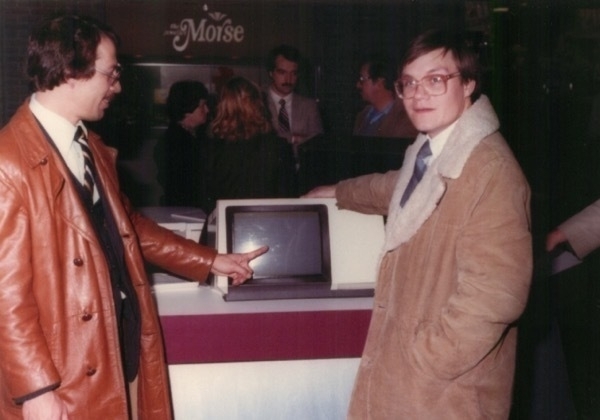
Russ Demchuk and Bruce Grayson check out the first install.
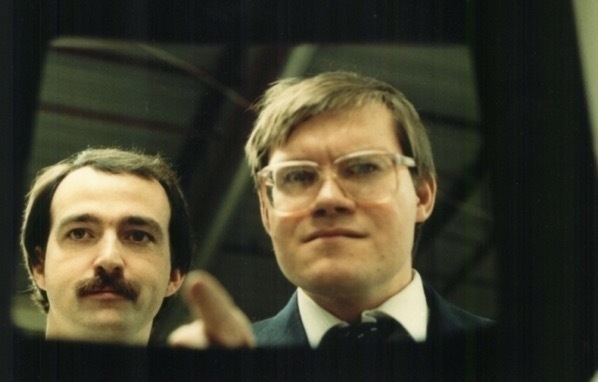 Frank Mandarino and Bruce Grayson try to use the Gift Guide, as seen from inside the terminal
Frank Mandarino and Bruce Grayson try to use the Gift Guide, as seen from inside the terminal
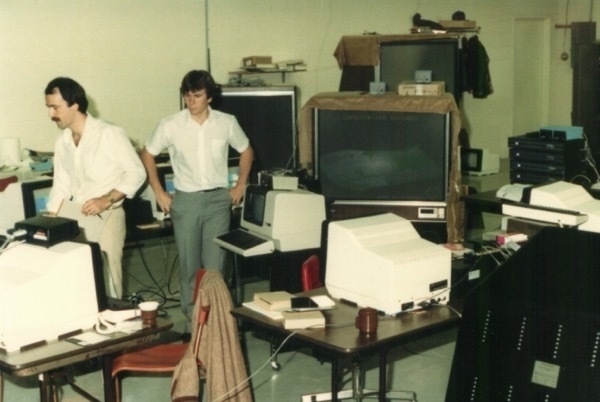
Frank, and Tom Martin, in the lab back at Cableshare
and maybe my favourite
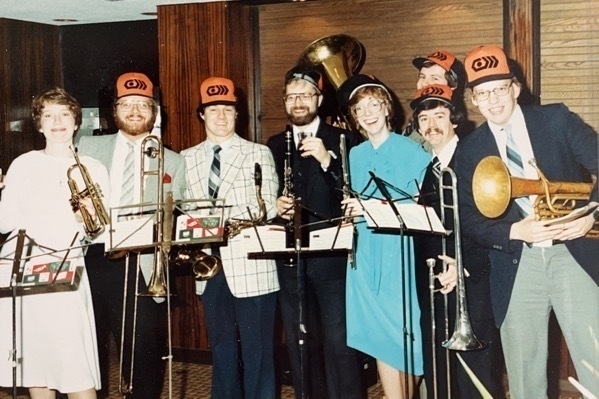
the Cableshare Marching Band, from the 1982 Christmas party.
In 1983 I went back to grad school at Waterloo, and Cableshare eventually pivoted to doing some sort of interactive thing over cable and phone lines and got acquired by another telco, and the booths faded away.
But it was a pretty amazing couple of years.
UPDATE!
I recently stumbled across this CBC video report from 1985 on Cableshare’s pivot to “Touch-n-Shop”, a system for shopping on your TV, controlling it via your touch-tone phone. This used the same Telidon graphics and Picture Painter software I’d built, but reorganized to run on your home TV. Cableshare was convinced they were on to something with this shopping-at-home idea, and JC Penney swooped in.
It’s great to see my former boss, Cableshare president Terry Pocock, in this. He took some big chances. I was only there a couple of years, but I learned a ton, and I have some great memories. Thank you, Terry.
Watch here:
https://www.cbc.ca/archives/the-little-company-that-promised-shopping-via-the-tv-in-1985-1.5755825
Presentation Tips you Might Not Want To Use
I’ve been fortunate to deliver sessions at Apple’s WorldWide Developer Conference (WWDC) in California on many occasions, and have learned some good things about presenting.
These are not those things. But I’ve saved them here for posterity, because I think after 20 years, the statute of limitations has expired.
Be Sure To Wear the Speaker Shirt
WWDC 2002, WebObjects Technical Overview
It’s important that everybody wear the special speaker shirt.
My thanks to engineering manager Toni Trujillo Vian who went along with this dumb idea that was presented to her about two minutes before the session started.
See If You can Get the Crowd to Stand and Sing
WWDC 2001, WebObjects Technical Overview
What session would not be improved with a singalong? Well, perhaps this one.
(This was actually the second time I got a WWDC crowd to stand and sing. In an earlier session on the very dry topic of WebObjects debugging, we staged the World WebObjects Debugging Championship at the end (between a couple of good-natured volunteers from the USA and Canada) and played the anthem of the winning country at the end. Congrats, Mark Ritchie of Canada.)
Apple + NeXT, 25 years ago today.
Remembering the merger of Apple and NeXT and how anxious we all were and how well it worked out. Also with a new baby.
Remembering NeXT's Black Monday. Or possibly Sunday.
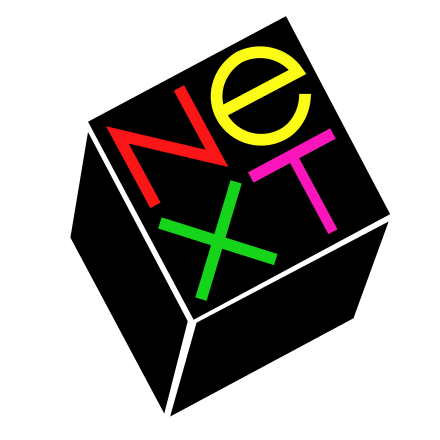
NeXT's Black Monday
Today’s the 28th anniversary of the day in 1993 that NeXT decided to
and not insignificantly
Including me, Systems Engineer for NeXT Canada.
(Later on, of course, Apple purchased NeXT and its software became the core of iOS, macOS, watchOS and tvOS, all running on hardware that was inconceivable to any of us in 1993.)
or possibly Sunday
Looking back at my calendar I see that February 7, 1993 was actually a Sunday, so I might be off by one in my reminiscing. But still. It was kind of a big deal, personally.
vague reminiscences, previously tweeted
I remember we all got an urgent voice mail and the entire NeXT Canada office - all 3 of us - were instructed to fly to Chicago immediately for some news.
That was an interesting trip as Phil, Paul and myself debated exactly what was going on and who was going to be left standing. We knew that the regional manager was out.
And we all got let go, effective immediately, and - I still can’t believe we felt we needed to do this - we went to visit our big customers back in Toronto in person the following day to let them know what was going on.
You know those tables where they assign numerical values to various stress factors? Getting laid off was one thing but we had also (2) just bought a house and (3) were expecting child #1. I needed a bigger chart.
I remain, however, eternally grateful to Trimark Investment Management, one of our biggest NeXT customers, because when we visited them to tell them all of NeXT Canada had been let go, they said “Huh. That’s unfortunate …. Steve do you want to do some consulting for us?”
Thus began the historic short life of the consulting firm of Steve Hayman and Associates *
One thing I remember from the layoff meeting in Chicago, where somebody I had never met before told me I no longer had a job. “I want to keep my computer.”
— OK … what computer do you have?
(Changed the subject quickly. I think I actually had two computers.)
One other thing I remember. Consulting for Trimark, they had a fleet of NeXT computers, I had one at home, so I bought a portable SCSI hard drive to carry my work back and forth because how else were you supposed to do it in 1993
a ONE GIGABYTE SCSI hard drive. Massive! And it was only $1000!
Today for $1000, you’d get, what, 50 terabytes? 50,000 times as much? Storage is 1/50,000 th of what it was? How many other things are 50,000 times cheaper? That’s basically FREE now.
I know this will come as a surprise to nobody but Steve Hayman and Associates was not exactly a huge success. (I blame the associates, of course.)
18 months later, as NeXT pivoted to software, the regional team - from Michigan - came to Toronto to present to, I forget who exactly, some bank or something. They kindly invited the entire Steve Hayman and Associates team to attend.
Before the session started, the NeXT team said in a kind of off-hand way, “Hey Steve, how about you do the presentation?”
I guess in retrospect it was kind of an audition.
And, whaddya know, I guess NeXT saw (one of) the error(s) of its ways, and offered me a job again.
note: it is possible I am still telling the same jokes in presentations, because, you know, Object Oriented programming encourages re-use
So, miraculously, even though this day in February 1993 was a very stressful low point for me and hundreds of others, I was lucky enough to get drafted by NeXT a second time.
For a while, NeXT Canada was me in Toronto, and a guy in Vancouver (hi Scott.) We’d phone each other on Memorial Day, or July 4, or US Thanksgiving just to verify the other guy was actually in the office.
I still have a surprising quantity of NeXT business cards. I keep those with my SCSI cables. Hey, you never know.
Audio Ping at 30
Thirty years ago today I achieved my first mild dose of Internet fame, with this post to the old comp.sys.next Usenet newsgroup. Here’s the original post first - and let me tell you about what happened afterwards. Also it involves ducks.
Date: Sun 23-Jan-1991 21:15:24 From: sahayman@iuvax.cs.indiana.edu (Steve Hayman) Subject: NeXT "audio ping" for network debuggingThe thinwire started messing up in the building where I work yesterday;
I was scurrying around with an ethernet terminator cutting off segments of the network to try to isolate where the problem was.I have a NeXT and a Sun on my desk, and was trying to ‘ping’ the Sun from the NeXT.
Whether it worked depended on where I cut the network off.ping is a good tool for debugging but it sure is a pain to have to run back to your office to see if any of the ping packets are getting through.
So I came up with this quick hack.
#!/bin/sh
audio-ping host
output of ‘ping’ looks like this:
# ping porbeagle
PING porbeagle.cs.indiana.edu: 56 data bytes
64 bytes from 129.79.254.138: icmp_seq=0. time=3. ms
64 bytes from 129.79.254.138: icmp_seq=1. time=3. ms
…
one line per second. no output is produced if the packets
aren’t coming back.
This script plays a sound whenever it sees a line with “icmp_seq” on it.
ping $1 2>&1 | while read line; do case “$line” in icmp_seq) sndplay ping.snd ;; esac done
Now start this up. Crank up the volume on your NeXT to the max.
You can now wander through the building fiddling with the network, unplugging different machines and so on; if it’s working you’ll hear this voice saying PING … PING … PING; if it quits working the voice will stop.If you wanted to get really fancy you could play a different sound for some of the other messages that ping might generate - sometimes ping says “network is down”, for instance.
This script helped me find a faulty tee-connector in just about a minute.
OK it’s a dumb hack.
Steve
ping? what's that?
ping is a Unix tool that attempts to make a connection to a remote computer, and once a second, it will print a line of received data. It’s a quick way to check if your network is working. Ping a faraway computer, and if you get a line of information back every second, your network is working.
I still use this today.
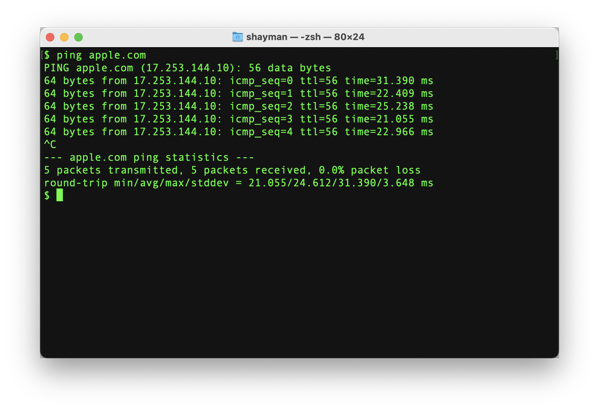
so what where you trying to do in 1991?
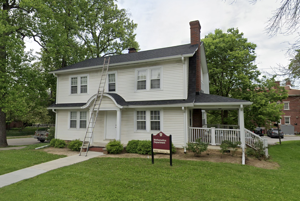
I was working for the computer science department at Indiana University - we’d temporarily been relocated to, I think, this building - while the main CS building was being renovated (and wow, did I ever wind up with a great office in the renovated building when it was done, Lindley Hall - corner office, top floor, overlooking the quad… and two weeks after we moved in, I quit to come back to Canada. I’ll never have an office like that again.)
Anyway. The network in our little house wasn’t working. I was running this ‘ping’ program and had to keep returning to my desk to see if it was working, as I experimented with changing network settings and futzing with cables on other computers in the building. We didn’t have portable computers, that’s for sure.
So what I did above was to combine the sound recording tool on my NeXT cube on my desk, with the Unix ping program, in a way that my computer would play a recording of me saying PING once a second when the network was working, and it’d be silent otherwise. I could then wander through the building adjusting things and when I heard the PING sound from upstairs, I knew I’d fixed it.
I didn’t think this was such a big deal but posted the above writeup to the net. A few people congratulated me.
and then what?
Somehow this little hack made it into the Jargon File, a legendary compilation of hacker terminology, and a subsequent book, The New Hacker’s Dictionary.. If you check the jargon file today, 30 years later, you can see this entry for ping-
ping [from the submariners' term for a sonar pulse] 1. n. Slang term for a small network message (ICMP ECHO) sent by a computer to check for the presence and alertness of another. The Unix command `ping(8)' can be used to do this manually (note that `ping(8)''s author denies the widespread folk etymology that the name was ever intended as acronym `Packet INternet Groper'). Occasionally used as a phone greeting. See ACK, also ENQ. 2. /vt./ To verify the presence of. 3. /vt./ To get the attention of. 4. /vt./ To send a message to all members of a mailing list requesting an ACK (in order to verify that everybody's addresses are reachable). "We haven't heard much of anything from Geoff, but he did respond with an ACK both times I pinged jargon-friends." 5. /n./ A quantum packet of happiness. People who are very happy tend to exude pings; furthermore, one can intentionally create pings and aim them at a needy party (e.g., a depressed person). This sense of ping may appear as an exclamation; "Ping!" (I'm happy; I am emitting a quantum of happiness; I have been struck by a quantum of happiness). The form "pingfulness", which is used to describe people who exude pings, also occurs. (In the standard abuse of language, "pingfulness" can also be used as an exclamation, in which case it's a much stronger exclamation than just "ping"!). Oppose blargh.The funniest use of
ping' to date was <strong>described in January 1991 by Steve Hayman</strong> on the Usenet group comp.sys.next. He was trying to isolate a faulty cable segment on a TCP/IP Ethernet hooked up to a NeXT machine, and got tired of having to run back to his console after each cabling tweak to see if the ping packets were getting through. So he used the sound-recording feature on the NeXT, then wrote a script that repeatedly invokedping(8)', listened for an echo, and played back the recording on each returned packet. Result? A program that caused the machine to repeat, over and over, “Ping … ping … ping …” as long as the network was up. He turned the volume to maximum, ferreted through the building with one ear cocked, and found a faulty tee connector in no time.
I gotta tell ya, to have your name mentioned in the Jargon File certainly gives you an aura of street cred in certain strange circles!
not only that
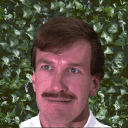
The Ping program itself was written by a legendary Unix developer at AT&T Bell Labs named Mike Muuss. He tragically passed away in a car accident in 2000 but his personal web site lives on, and I was delighted to see his page titled, The Story of the Ping Program.
He tells the interesting story of the birth of this program and then - much to my delight - includes this anecdote, which is mostly accurate
The best ping story I've ever heard was told to me at a USENIX conference, where a network administrator with an intermittent Ethernet had linked the ping program to his vocoder program, in essence writing:ping goodhost | sed -e 's/.*/ping/' | vocoderHe wired the vocoder’s output into his office stereo and turned up the volume as loud as he could stand. The computer sat there shouting “Ping, ping, ping…” once a second, and he wandered through the building wiggling Ethernet connectors until the sound stopped. And that’s how he found the intermittent failure.
Imagine my delight at stumbling across that, from the author of ping himself.
the best part
There’s a famous children’s book from 1933 called “The Story about Ping”. It’s about a duck, of course. A Duck! Ping, a spirited little duck who lives on a boat on the Yangtze River and gets into various misadventures. It’s about a duck. A duck named Ping.
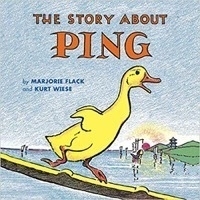
But Mike Muuss’s page mentioned this legendary Amazon review of the book which still makes me laugh today.
Customer CommentsA reader from Upper Volta, Uzbekistan, March 7, 1999
Excellent, heart-warming tale of exploration and discovery. Using deft allegory, the authors have provided an insightful and intuitive explanation of one of Unix’s most venerable networking utilities. Even more stunning is that they were clearly working with a very early beta of the program, as their book first appeared in 1933, years (decades!) before the operating system and network infrastructure were finalized.
The book describes networking in terms even a child could understand, choosing to anthropomorphize the underlying packet structure. The ping packet is described as a duck, who, with other packets (more ducks), spends a certain period of time on the host machine (the wise-eyed boat). At the same time each day (I suspect this is scheduled under cron), the little packets (ducks) exit the host (boat) by way of a bridge (a bridge). From the bridge, the packets travel onto the internet (here embodied by the Yangtze River).
The title character – er, packet, is called Ping. Ping meanders around the river before being received by another host (another boat). He spends a brief time on the other boat, but eventually returns to his original host machine (the wise-eyed boat) somewhat the worse for wear.
The book avoids many of the cliches one might expect. For example, with a story set on a river, the authors might have sunk to using that tired old plot device: the flood ping. The authors deftly avoid this.
Who Should Buy This Book
If you need a good, high-level overview of the ping utility, this is the book. I can’t recommend it for most managers, as the technical aspects may be too overwhelming and the basic concepts too daunting.
Problems With This Book As good as it is, The Story About Ping is not without its faults. There is no index, and though the ping(8) man pages cover the command line options well enough, some review of them seems to be in order. Likewise, in a book solely about Ping, I would have expected a more detailed overview of the ICMP packet structure.
But even with these problems, The Story About Ping has earned a place on my bookshelf, right between Stevens' Advanced Programming in the Unix Environment, and my dog-eared copy of Dante’s seminal work on MS Windows, Inferno. Who can read that passage on the Windows API (“Obscure, profound it was, and nebulous, So that by fixing on its depths my sight – Nothing whatever I discerned therein."), without shaking their head with deep understanding. But I digress.
Rejoining the Breakpoints after 17 years
So I played in a band at the legendary Ritz in San Jose, California last night.
(below are some of the many great photos of the event by Adam Tow)

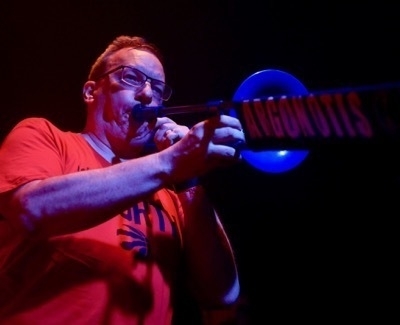
The whole event reminded me that it’s not really important how good a musician you are; you should just get together with your friends and play some music. (And maybe people will come! And they did, in this case; the event was a fundraiser for App Camp for Girls )
Wait, whaaat? What band are you in NOW? I thought the whole football band thing was over. Well, yeah it still is. This time I sat in with James 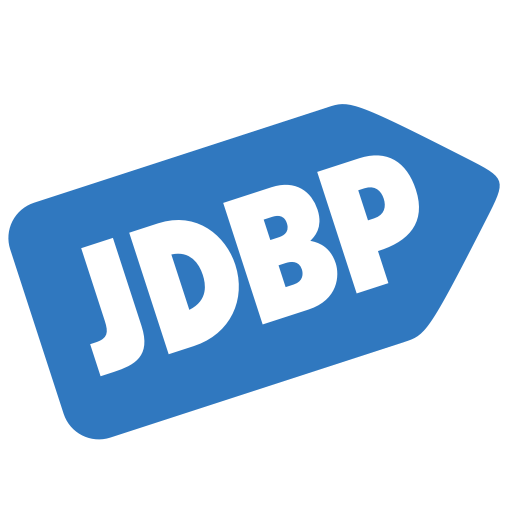 Dempsey and the Breakpoints at their 8th annual Live Near WWDC concert.
Dempsey and the Breakpoints at their 8th annual Live Near WWDC concert.
This is an annual concert put on by people attending Apple’s World Wide Developer Conference, and it’s spearheaded by my friend James who has written an entire chart-topping album of funny songs celebrating various technical aspects of programming and you can of course listen to the whole album here.
The band featured a whole group of people who are stars in the Mac world - including Daniel Jalkut, author of MarsEdit, the blogging software I am typing in right now - and many other luminaries that I bet most of my friends outside the Mac world have never heard of. But I don’t care! It was great fun to be invited!
for instance
Here’s one of my favourite numbers - The Liki Song (Minawana Meika La’a Likiko)
It’s a little Hawaiian number with James on ukulele - and it’s about memory management. I have to admit, the first time I listened to it - while walking through an airport - I had no idea what the heck James was singing about. “Liki” ? “Mina wana meika la’a likiko”? What the heck? What is he talking about?
And finally it dawned on me - “Me no want to make a lot of leaky code.” That stopped me in my tracks in the airport; I had to sit down, I was laughing so hard. And this was the big closing number at the show, with 24 musicians on stage and the entire crowd singing along. What a treat. So many songs, so many different styles.
how'd this start?
James and I both worked at Apple ages ago - I still do - and both presented at WWDC many times. I distinctly remember one year when I was getting ready for my talk and Matt Firlik announced to me that James had written an original song about Fetch Specifications for his talk, and right then, I knew the best any of the rest of us could hope for was to give the 2nd best presentation.
For years afterwards, the word would get out that James’s WWDC session was almost over and, regardless of topic, people would suddenly arrive for the last 5 minutes to hear his latest song about localization or the perils of designated initializers or whatever else struck his fancy.
A year or two later in 2002, he wrote another song at the developer conference about memory management called Hold Me, Use Me, Release Me - and I knew I had to up my game, and brought my trombone on stage for my own session on WebObjects and I told the crowd that I’d written an original trombone solo about Key-Value Coding, which I hoped I’d have time to perform.
To the great relief of everyone, including me, I did not have time to perform this (nonexistent) solo. But there was some sort of community event that night and James was asked to reprise the Hold Me song, and, well I happened to be around and happened to have a trombone on hand and my arm was twisted ever so slightly so I played along on stage with James.
And that was the last time I did, until 17 years later.
(Ten years later, I was visiting Cathy’s mom at her home in a tiny community in northern New Brunswick and tweeted something about it, and about five minutes later, the phone rang - it was James. “Are you really in Jacquet River, New Brunswick?” he asked in amazement - because it turns out his wonderful father Wilbur lived there too! Small world.)
the breakpoints
James eventually struck out on his own and formed a band of various other members of the geek-Apple community - all very talented musicians - and called the group the Breakpoints. (A breakpoint is a term in software debugging for a location where you want the program to stop so you can see what’s going on.)
He actually wound up with enough material to release an entire album of funny programming songs songs which actually was the #1 comedy album on iTunes for a while (and, if I remember correctly, #1 overall album in Bulgaria).
I was lucky enough to be dubbed a “conditional breakpoint”, i.e. someone who played with the band only rarely.
For years James and his band did these wildly popular fundraisers called “Live Near WWDC”, and I always went, and always enjoyed it, and always secretly wanted to be up there on stage too.
the show
Last night was my chance. 17 years after first playing with James, I was invited back to play trombone on a couple of numbers, including a rockin' round of trading licks with awesome guitarist Jim Dalrymple, in a song which could only have been improved if I had not forgotten what key it was in part way through. (note: it was in “A”.)
I am saving this tweet -
You are amazing!
— Jim Dalrymple (@jdalrymple) June 6, 2019
Wow, was it fun. Over 20 different muisicians in the band - singers, guitarists, drummers, a violin! a cello! And a guy with a blue trombone having the time of his life.
Thank you James. And thanks for the selfie below which you actually took during the middle of my solo, which perhaps caused me to forget the key signature (note, again: “A”)
I hope I can do it again in 2036. Maybe sooner!
